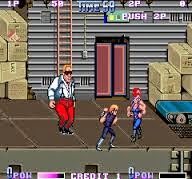Double Dragon was an amazing and extremely influential game that forged an entirely new genre which continues even to this day, but this review isn't about Double Dragon. This is a review of its sequel, Double Dragon II: The Revenge.
Much like its predecessor, Double Dragon II: The Revenge sticks to the traditional Beat 'em Up game formula, mostly because at the time it wasn't a formula yet, it was just how the first game was made. In my review of Bad Dudes vs. Dragon Ninja I mentioned how much The Double Dragon series influenced some of the most fondly remembered arcade games of the following decade. Being the second game in the series, the developers wanted to expand the game in new directions, so looking back it's interesting to see which choices were innovations that continued through the years, and which were annoyances quickly abandoned by the genre.
The worst choice made during the development of Double Dragon II struck me right away as I started playing it. The first game had punch, kick, and jump buttons that could be combined for additional moves. These moves all attacked in the direction your character was facing, so attacking the guy behind you meant turning around first. This is pretty standard in the world of videogames, but for the sequel somebody decided to get creative. The three buttons in Double Dragon II are jump, attack left, and attack right. Attack the direction you face to punch, and attack behind you to kick. This means that to alternate punches and kicks on the enemy in front of you, you'll need to spin back and forth. I thought I might get used to it after a while, but even by the end of playing through the entire game this control scheme never really felt comfortable.
These levels have more defined boss battles at the end of them than Double Dragon II's predecessor did. While the first game would throw some harder enemy waves at you at the end of each map, this one has specific boss characters, which by then had become the norm for the genre. Moving from one level to the next was a continuous flow this time around as the game map simply kept scrolling into the next area rather than cutting to a new location. This gave the player the feel of a single large continuous world, an innovation that was still being applauded as a fresh idea ten years later when Half Life did it. Some games still struggled with this decades later. In fact, the only time the view actually cuts is when entering the door to the hideout.
While the pressure to not only duplicate the runaway success of the first Double Dragon, but also get it into arcades by the following year must have stifled some of the potential originality of this title, it still managed to have some memorable moments of its own. The fight in front of the wheat harvester, the supernatural enemies who disappear from their collapsing armor upon death, and sometimes reappear unexpectedly, and the moment when your own shadow comes to life and attacks you all stand out in my mind as things Double Dragon II simply got right.
If you've only played the NES port of Double Dragon II: The Revenge, you might be surprised by how much isn't in the arcade release. The home version not only has about twice the number of levels, it added cut-scenes between these levels to advance the story. Given that this game wasn't nearly as popular in arcades as the first one, there was less motivation to keep the home release faithful. The NES port also changed the ending to make it happier, if less realistic.
The graphics are a small step up this time around. No giant leaps on a technical level, but it seems like building on the experience of making the first one lead to a nicer looking sprite set. Some specific details stood out as really nice touches such as the helicopter's shadow on the ground, the reflections in the hideout's floor, and the chain link fence you can walk behind. Other graphics looked like they were changed simply for the sake of being different. The cartoony hand pointing your way forward after a wave of thugs has been defeated was replaced with a lady's hand wearing bright nail polish. Maybe this is supposed to represent being guided by the spirit of your dead girlfriend?











No comments:
Post a Comment